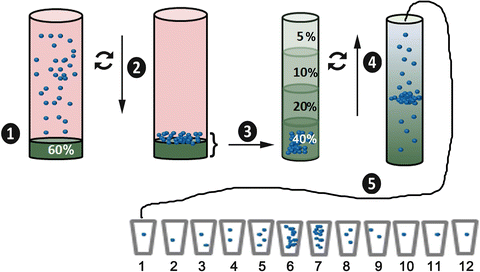From sedimentation to centrifugation
The natural settling of matter in a lake or in the ocean is precipitation or sedimentation. Sedimentation is a gravity-driven process that can be used to separate materials with different molar masses. But, normally it is so slow that you would only use it for the crudest type of separation. Approximately 100 years scientists developed methods to accelerate the process of separation by sedimentation. The centrifuge applies an artificial field that can be thousands of times larger than gravity. Small centrifuges may use from 1000 to 20,000 rpm. The ultracentrifuge uses vacuum to permit the rotor to reach rates of 50,000 rpm. By increasing the centripedal force to such large values separations can be affected on time scales ranging from hours to minutes depending on the molar masses in the sample.
 |
1). Place a 2 mL solution of 60% iodixanol below the pre-cleared conditioned medium that serves to cushion the nanoparticles during centrifugation; (2) sediment the nanoparticles at 100,000 × g for 3 h; (3) remove the 2 mL cushion along with 1 mL of overlaying medium and place it below a pre-formed step density gradient composed of three layers of iodixanol solution, 3 mL each; (4) perform density gradient ultracentrifugation at 100,000 × g for a period of 18 h; (5) collect the medium from the top of the tube in 1 mL increments. Exosomes derived from cultured primary BMDM typically are isolated in fractions 6 and 7
Li K, Wong DK, Hong KY, Raffai RL. (2018) Cushioned-Density Gradient Ultracentrifugation (C-DGUC): A Refined and High Performance Method for the Isolation, Characterization, and Use of Exosomes. Methods Mol Biol 1740:69-83